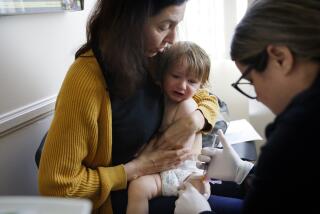GETTING BACK TO SCHOOL : Vaccination Rate in Brea Bodes Well
- Share via
The first day of school went off with just the usual start-up jitters Wednesday at Brea Junior High School--the county’s first public middle school to resume classes under a new state law requiring incoming seventh-graders to show proof they’ve been vaccinated for hepatitis B.
Despite concerns from state and county officials that large numbers of students would be turned away because they lack the necessary paperwork, no students were sent home from Brea Junior High, said Principal Mike Condiff.
Instead, the day brought the usual: Lost students looking for lockers and having difficulty opening them when they did find them.
“All the kids just look shiny-nosed in their new school clothes,” Condiff said. “I think we did a good job of letting parents know.”
The new law--effective July 1--requires all incoming public and private school seventh-graders to have at least started the three-dose hepatitis B series before the first day of school. Hepatitis B is an infection of the liver caused by a virus in the blood or other bodily fluids. The vaccination has been available since 1982 and for two years now, California kindergartners have been required to show proof of vaccination. By adding a second vaccination checkpoint at seventh grade, officials hope to catch unprotected children as they approach the years during which the disease is often contracted.
State health officials had worried that up to 145,000 incoming seventh-graders would not have the vaccination in time. And county officials had speculated that untold numbers of the 35,000 incoming seventh-graders could be sent home. County officials wouldn’t speculate Wednesday about what next week might bring--when most of the county’s public campuses on the traditional school calendar open their doors--but if Brea Junior High is an example, previous fears may prove unfounded.
“Everybody’s been ready to roll” to get the vaccination requirement completed for the first day of school, Condiff said.
In fact, because of early district notification and parents’ quick response, nearly all of Brea’s incoming 500 seventh-graders received clearance at the school’s orientation sessions last week after showing proof of vaccination.
Health clinics throughout the county reported double the number of preteens rolling up their sleeves last week as students rushed to make the deadline.
Still, Condiff acknowledged that the first day could have been a nightmare had the planning not paid off.
“When the seventh-graders are so excited, you don’t want to have a situation where you turn them away. That would have been a negative way to start. Our goal was to not let that happen,” he said.
Fullerton School District officials said they expect similar success when classes being next week. Out of the 400 or so incoming seventh-graders at Ladera Vista Junior High, administrators know of only a handful who could be turned away.
“Honestly, we don’t expect a big problem. [Parents and kids] have heard it loud and clear that this is a reality,” said Ellen Fisher, a district specialist for child welfare and attendance. “We’ve been informing parents now for two years about the hepatitis B requirement.”
But frustrated officials with Capistrano Unified say that although they’ve worked feverishly to get the word out before school starts Sept. 9, a third of their students are still short of the required paperwork. The district has offered free clinics and sought to inform parents through personal phone calls and a media campaign. As one county official put it: “For some parents, it’s like paying taxes.”
Still, the compliance rate is better than a month ago, when officials estimated that about 70% of students lacked the documentation.
“We keep [saying]: ‘If you don’t have your immunizations, you can’t come to school,’ ” said district spokeswoman Julie Jennings. “It’s really a health issue. It’s a state law and we have to implement that.”
County health officials said they expect to know in October how many seventh-graders complied, and will follow up on those students who haven’t completed the inoculation series. “This is just one hurdle, getting them in the front door” for the first shot, said Mary Wright, county immunization project coordinator.
More to Read
Sign up for Essential California
The most important California stories and recommendations in your inbox every morning.
You may occasionally receive promotional content from the Los Angeles Times.










